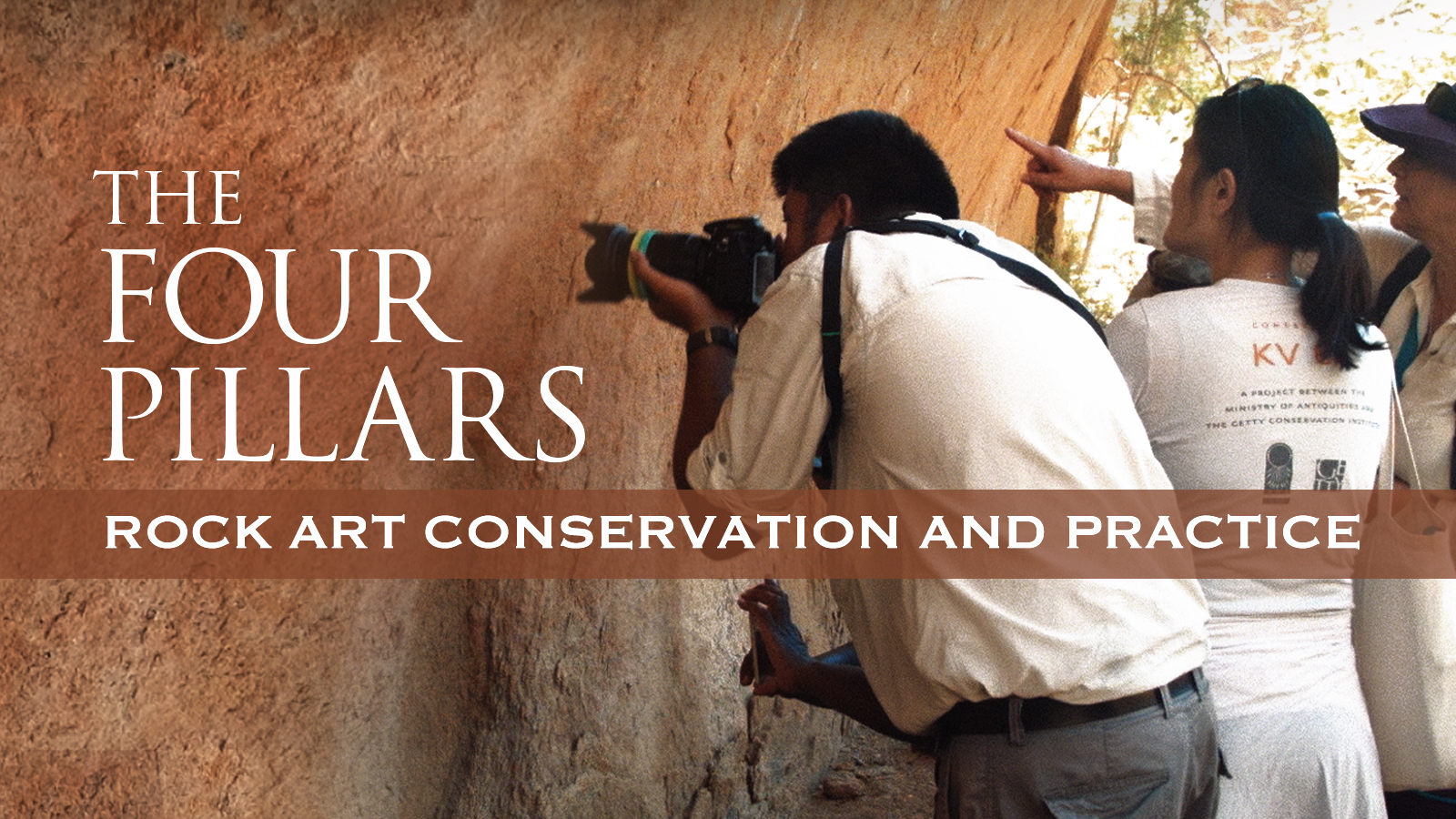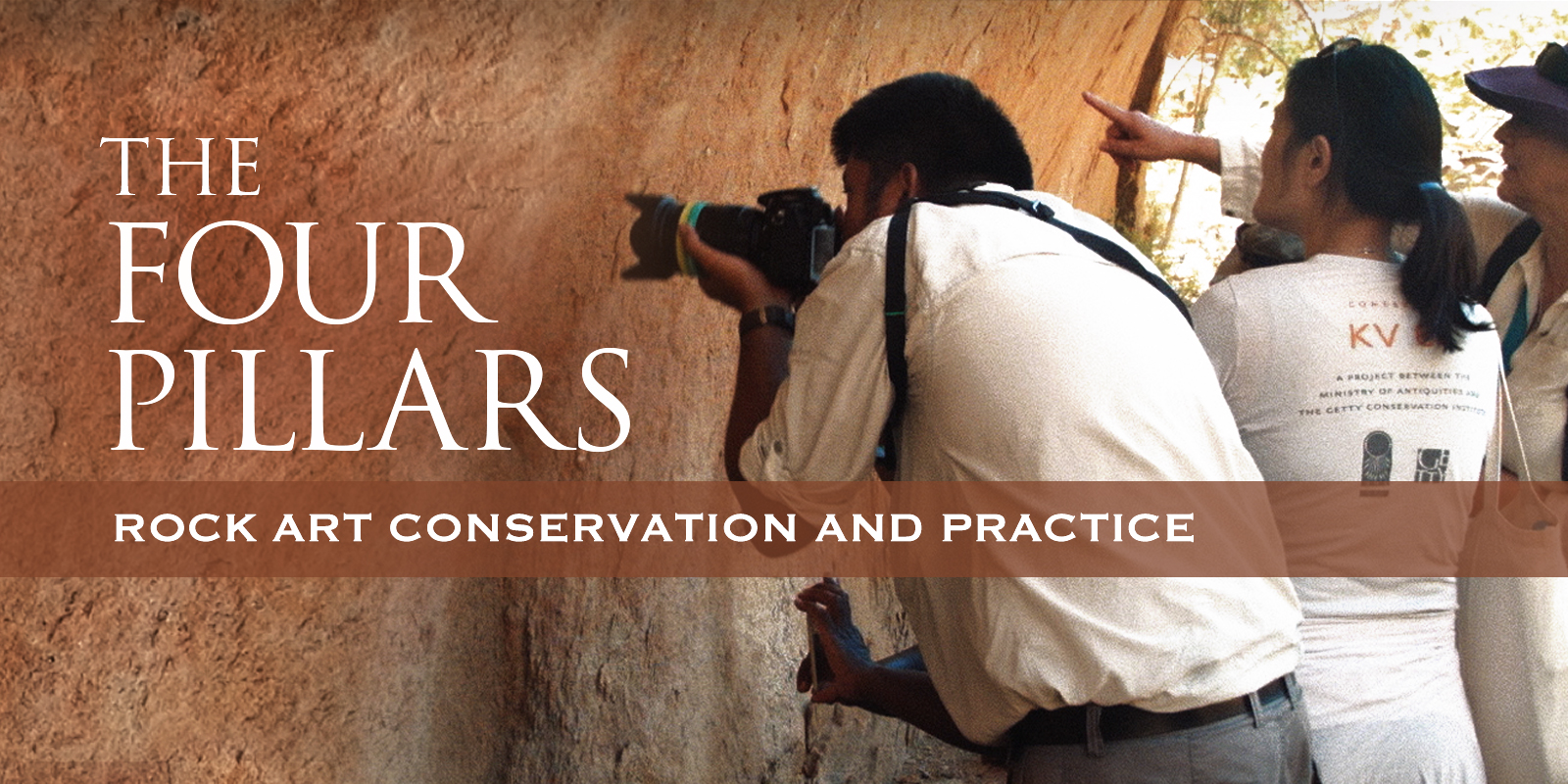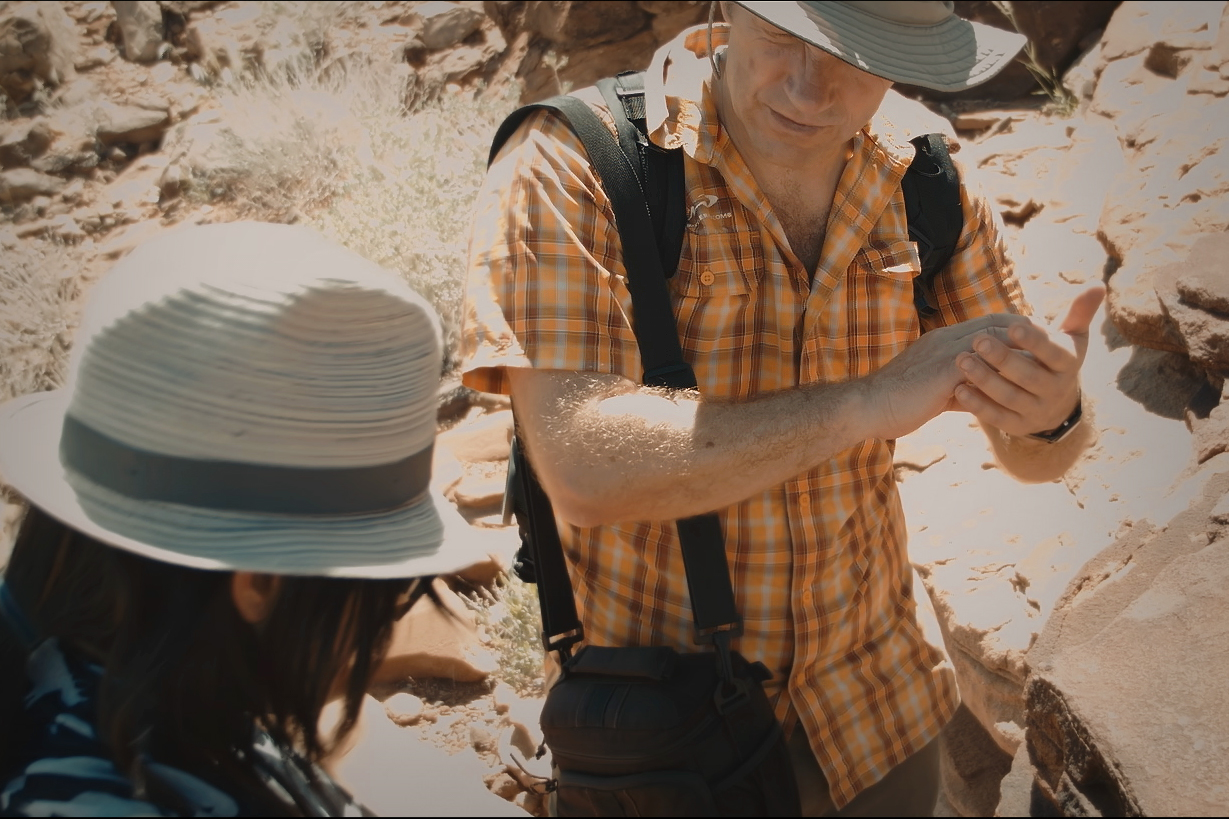


The Rock Art Network four ‘pillars’ make for strong rock art conservation in practice. This section sets out these four important areas of practice, citing a vision for what each aims to achieve, a summary of the key issues for each, a set of principles to guide practice at a more specific level and an outline of what needs to be done to improve policy and practice.
Nicholas Hall
Director, Stepwise Heritage and Tourism Pty. Ltd., Australia
While there are many published studies that concentrate on rock art management, the vast majority of these concentrate on formal systems of site recording and documentation. Relatively few concentrate on how this documentation is utilized in rock art protection and management programs. The Rock Art document sheds light on this underdeveloped area. In doing so, it also emphasizes the need for recognition of traditional forms of managing rock art sites where these may be in operation.
An overview of the principles that underpin this pillar are as follows:
- Manage to protect all values
- Recognize and respect traditional management methods
- Manage sites in their landscape setting
- Ensure that the necessary range of skills and associated research is part of the management process
- Recognize relationships of people to place
- Document sites according to recognized standards and protocols
- Document management programs in the form of a management plan
- Record management actions as part of a site’s history
- Monitor for changes in site conditions
- Provide public access sites with a heightened level of management attention
- Practice regular maintenance
There is a range of recognized practices that often contribute to rock art management programs.
Management Plans
Management plans, whether for single sites or areas or collectives of sites, are still a fundamental tool; they are the means to implement a management system. They help cultural heritage management needs to be heard and recognized in operational systems. They provide the basis for funding applications and budget bids, and they set strategic future directions.
Field Recording
The methods used to record rock art sites in the field are many and varied and are highly specific to the needs of the site, the skills of the recorder, the time and money available, and the purpose to which it is envisaged records are to be put. Increasingly, digital methods of documenting sites in the field are being used, and this greatly enhances the speed at which data can be collected and collated and can improve the efficiency of standardizing methods. A vast amount of effort has been devoted to the task of recording rock art sites, but the challenge of what happens to recordings and how they are stored, accessed, and used in the future remains a major issue.
Technical Recording
Alongside field recording methods, which place an emphasis on recording locations of sites in the landscape and the key features associated with them, highly detailed recording methods are being used to document sites such as 3D laser scanning. Whereas only a decade ago 3D scanning required expensive equipment and highly skilled operators, today an app on a smartphone can produce a 3D model in minutes on site. Likewise, image enhancement can be done in the field whereas in the past it took a great deal of time and considerable expertise. The increasing sophistication of recording methods provides opportunities for enhanced capacity to manage sites. The risk, however, is that rapidly advancing technology leaves in its wake a trail of experimental documentation and challenges to archival storage and access that make it very difficult to use such recordings for practical management purposes. It is important to concentrate on a range of basic practices for documentation that can form the core of management standards and to use these as a reference to direct and harness the potential of new methods and technologies for the purposes of management.
Database Systems
Increasingly, rock art records are being stored digitally. As large quantities of information are collected in the field, the real challenge is to effectively manage the data, keep it safe, and then make it available to those who need it. Various forms of database systems have been developed to assist in this task. These are not just archival systems; in some cases they are incorporating management functions that enable site information to be used and updated much like an asset management system.
Monitoring
Keeping watch on sites for signs of change has always been seen as a laudable practice, but one that more often than not falls by the wayside or otherwise tends to be done through ad hoc and highly subjective activities. There are relatively few documented examples where monitoring systems have been developed using a range of appropriate methods that have been applied in a sustainable way over an extended period of time. Much more attention needs to be put into structured monitoring methods and processes. Emphasis should still be on simple and reproducible methods and by engaging local communities to play roles as site monitors. Technical analysis of condition factors affecting sites over time can be a complex matter that requires collaboration and peer review to ensure that the right questions are being asked and that the best methods are being employed to address those questions.
Maintenance
Maintenance at sites can take many forms, from traditional practices of maintaining the significance of sites through to regular work on risk reduction, such as reducing vegetation to lower the risk of wildfires to a site.
Training Systems
Management is essentially an activity determined by the capacities of human resources. The skills people use to perform management actions, the social way in which they cooperate to undertake work, and the processes and procedures involved all require intentional training to make the efforts effective. Investing in human capital, not just the physical infrastructure placed on sites, is an essential part of management. Systems need to be put in place to continually train new people and refresh and upskill others.
Information Use
Information that is recorded about rock art sites or that is revealed in the course of managing sites can be culturally and politically sensitive. Protecting the intellectual property rights of knowledge holders, and negotiating and making agreements regarding the use of information, is a fundamental part of management and not an inconvenient by-product.
In Rock Art: A Cultural Treasure at Risk, management systems are envisaged as a means to manage rock art sites within their physical setting as part of a landscape. A management system is simply the framework of policies, processes, and procedures used by an organization to ensure that it can fulfill all the tasks required to achieve its objectives.
The International Organization for Standardization (ISO) is the international warehouse for standards on a wide range of topics and collects sector-specific management system standards (MSS). ISO has a management system for environmental management. The core components of a management system require definition of the following:
- The organization responsible.
- Stakeholders.
- Policies relating to the management system.
- Objectives of the management system.
- Risk management approaches.
- Competence/skills required.
- Information to be maintained.
- Communication.
- Processes involved in the management system.
- Performance measures and evaluation.
- Monitoring of the management system.
- Improvements based on the management system (continuous improvement).
Management systems in the case of ISO accreditation are formally documented. These systems are then expected to perform with reference to the set of associated international standards of practice.
When it comes to rock art sites, management systems have tended to develop organically. At Iringa in Tanzania, a local community group, Kiumaki, was formed to protect the environment, undertake microeconomic projects, and build capacity in the local community. They have taken on a custodial role for the Igeleke Rock Paintings that includes site monitoring, maintenance, and guiding, and they maintain a system of staff training to ensure these roles can continue over time (Kiumaki 2017). This is a form of management system, implemented by a local community. Most often it has been cultural heritage management practices in protected areas that have brought a systematic approach to the task of looking after rock art sites, however. At Petrified Forest National Park in Arizona in the US, rapid condition assessments were undertaken on more than 3,500 sites. This information was used as the basis for identifying and prioritizing future management actions (Cerveny et al. 2016).
In the East Alligator River Region of West Arnhem Land in the Northern Territory of Australia, Njanjma Rangers are an Aboriginal group who look after natural and cultural heritage within their traditional clan estates (Njanjma Rangers and Stepwise Heritage and Tourism 2017). The landscape of sandstone escarpments and outliers contains thousands of rock art sites, some of which are in the World Heritage–listed Kakadu National Park, but many of which lie outside, otherwise lacking the resources that the neighboring protected area receives. Looking after bim (rock paintings) is very important to Bininj (local Aboriginal people), and with a small staff, deciding where and how to use precious resources can be difficult. As part of its overall approach to being accountable and develop good business systems, Njanjma Rangers are establishing a rock art management system that is being designed to do the following:
- Provide a practical method of recording sites efficiently in the field.
- Develop a means to prioritize management at sites using a combination of heritage significance and identification of risks.
- Establish a standardized monitoring method for sites.
- Target high-priority sites for additional recording, monitoring, and maintenance attention.
- Develop procedures to handle management actions such as weed reduction, fire management, and graffiti response.
- Train rangers in the procedures and field methods using a “train-the-trainer” approach.
- Manage site data and keep records of management activity that can be used to demonstrate accountability for the “service” that rangers provide in cultural heritage management.
Bininj want to be known as leaders in their work on rock art, and the management system has been set up to make sure their experience is shared with other Aboriginal ranger groups and hopefully with others developing rock art management programs elsewhere. Further information on the work of Njanjma Rangers in protecting rock art can be found at www.njanjmabim.net
What should management systems, as they apply to rock art sites, look like? What are the components that might form the basis for a standard of practice? A starting point would be that a management system for rock art should include the following:
- Operationalize the means by which management and conservation is guided by an understanding of the values of the site(s).
- Recognize, incorporate, and use different forms of knowledge and expertise.
- Provide an inclusive process for stakeholders.
- Present a plan or management system that integrates and responds to the physical, cultural, and political aspects of management.
- Provide clear responsibility and authority for the plan and implementation, monitoring, and reporting mechanisms.
- Advocate conservation and management approaches that do as much as necessary, but as little as possible.
- Set out a systematic approach to monitoring of sites implemented as part of a plan or management system.
- Provide for plans and procedures for risk management, including response to disasters and emergency.
- Establish a means for ongoing communication between stakeholders.
- Incorporate evaluation, review, and revision of the plan or monitoring system.
How do we go about developing best-practice frameworks for management systems? Is there value in doing this? If so, how best to achieve this? How would it be championed? How can benchmark standards be set?
How do we demonstrate best practice in management? How can we link and promote demonstration sites that people can look to for inspiration?
Applied areas of research into management methods have not played a prominent part in rock art research. How can we actively promote more research into management practices?
Is a training component needed to help people apply best practice methods and frameworks locally?
Cerveny, Niccole V., Ronald I. Dorn, Casey D. Allen, and David S. Whitley. 2016. Advances in rapid condition assessments of rock art sites: Rock Art Stability Index (RASI). Journal of Archaeological Science: Reports 10: 871–77.
Kiumaki (Iringa, Tanzania). 2017. “Kiumaki (Kikundi Cha Utunzaji Mazingira Na Kihesa Kilolo).” https://envaya.org/kiumaki/home
Njanjma Rangers and Stepwise Heritage and Tourism. 2017. “Kunwardde Bim Karridurrkmirri = Working for Rock Art.” Retrieved from http://www.njanjmabim.net/
→ Members and affiliated institutions of the Rock Art Network
by
George Nash
5/09/2024 Recent Articles
→ Sigubudu: Paintings of people with guns in the northern uKhahlamba-Drakensberg
by Aron Mazel
22/07/2024
by Richard Kuba
13/06/2024
by Meenakshi Dubey-Pathak
8/03/2024
by Rock Art Network
6/02/2024
by Rock Art Network
14/12/2023
by Sam Challis
5/12/2023
by Aron Mazel
30/11/2023
by Sam Challis
21/11/2023
by Sam Challis
15/11/2023
by Sam Challis
10/11/2023
by Rock Art Network
6/11/2023
by Rock Art Network
3/11/2023
by Aron Mazel
2/11/2023
by Meenakshi Dubey-Pathak
26/09/2023
by Paul Taçon
24/08/2023
by Aron Mazel
13/06/2023
by Paul Taçon
5/06/2023
by Paul Taçon
15/03/2023
by George Nash
14/03/2023
by Noel Hidalgo Tan
10/02/2023
by George Nash
01/02/2023
by Meenakshi Dubey-Pathak, Pilar Fatás Monforte
29/11/2022
by Aron Mazel, George Nash
21/09/2022
by Paul S.C. Taçon, Sally K. May, Ursula K. Frederick, Jo McDonald
07/07/2022
by Meenakshi Dubey-Pathak
26/07/2022
by Paul Taçon
20/07/2022
by David Coulson
16 June 2022
by Paul Taçon
25 April 2022
by Noel Hidalgo Tan
20 April 2022
by Meenakshi Dubey-Pathak
14 March 2022
by Carolyn Boyd & Pilar Fatás
02 March 2022
by David Coulson
07 February 2022
by Johannes H. N. Loubser
06 February 2022
by Meenakshi Dubey-Pathak
05 February 2022
by Aron Mazel
28 January 2022
by Aron Mazel
8 September 2021
by David Coulson
17 August 2021
by Ffion Reynolds
21 June 2021


by Aron Mazel
22/07/2024
by Richard Kuba
13/06/2024
by Meenakshi Dubey-Pathak
8/03/2024
by Rock Art Network
6/02/2024
by Rock Art Network
14/12/2023
by Sam Challis
5/12/2023
by Aron Mazel
30/11/2023
by Sam Challis
21/11/2023
by Sam Challis
15/11/2023
by Sam Challis
10/11/2023
by Rock Art Network
6/11/2023
by Rock Art Network
3/11/2023
by Aron Mazel
2/11/2023
by Meenakshi Dubey-Pathak
26/09/2023
by Paul Taçon
24/08/2023
by Aron Mazel
13/06/2023
by Paul Taçon
5/06/2023
by Paul Taçon
15/03/2023
by George Nash
14/03/2023
by Noel Hidalgo Tan
10/02/2023
by George Nash
01/02/2023
by Meenakshi Dubey-Pathak, Pilar Fatás Monforte
29/11/2022
by Aron Mazel, George Nash
21/09/2022
by Paul S.C. Taçon, Sally K. May, Ursula K. Frederick, Jo McDonald
07/07/2022
by Meenakshi Dubey-Pathak
26/07/2022
by Paul Taçon
20/07/2022
by David Coulson
16 June 2022
by Paul Taçon
25 April 2022
by Noel Hidalgo Tan
20 April 2022
by Meenakshi Dubey-Pathak
14 March 2022
by Carolyn Boyd & Pilar Fatás
02 March 2022
by David Coulson
07 February 2022
by Johannes H. N. Loubser
06 February 2022
by Meenakshi Dubey-Pathak
05 February 2022
by Aron Mazel
28 January 2022
by Aron Mazel
8 September 2021
by David Coulson
17 August 2021
by Ffion Reynolds
21 June 2021
Friend of the Foundation


by Aron Mazel
22/07/2024
by Richard Kuba
13/06/2024
by Meenakshi Dubey-Pathak
8/03/2024
by Rock Art Network
6/02/2024
by Rock Art Network
14/12/2023
by Sam Challis
5/12/2023
by Aron Mazel
30/11/2023
by Sam Challis
21/11/2023
by Sam Challis
15/11/2023
by Sam Challis
10/11/2023
by Rock Art Network
6/11/2023
by Rock Art Network
3/11/2023
by Aron Mazel
2/11/2023
by Meenakshi Dubey-Pathak
26/09/2023
by Paul Taçon
24/08/2023
by Aron Mazel
13/06/2023
by Paul Taçon
5/06/2023
by Paul Taçon
15/03/2023
by George Nash
14/03/2023
by Noel Hidalgo Tan
10/02/2023
by George Nash
01/02/2023
by Meenakshi Dubey-Pathak, Pilar Fatás Monforte
29/11/2022
by Aron Mazel, George Nash
21/09/2022
by Paul S.C. Taçon, Sally K. May, Ursula K. Frederick, Jo McDonald
07/07/2022
by Meenakshi Dubey-Pathak
26/07/2022
by Paul Taçon
20/07/2022
by David Coulson
16 June 2022
by Paul Taçon
25 April 2022
by Noel Hidalgo Tan
20 April 2022
by Meenakshi Dubey-Pathak
14 March 2022
by Carolyn Boyd & Pilar Fatás
02 March 2022
by David Coulson
07 February 2022
by Johannes H. N. Loubser
06 February 2022
by Meenakshi Dubey-Pathak
05 February 2022
by Aron Mazel
28 January 2022
by Aron Mazel
8 September 2021
by David Coulson
17 August 2021
by Ffion Reynolds
21 June 2021
Friend of the Foundation















